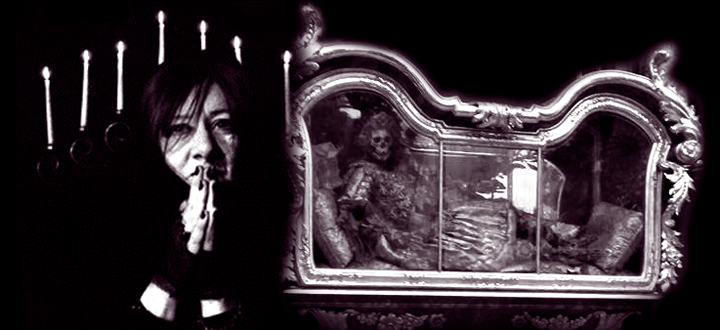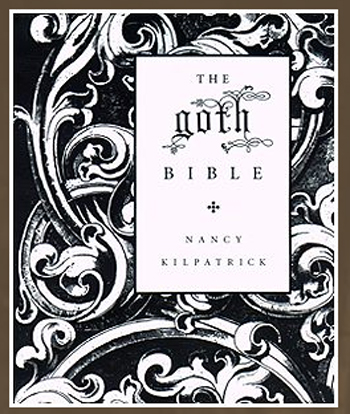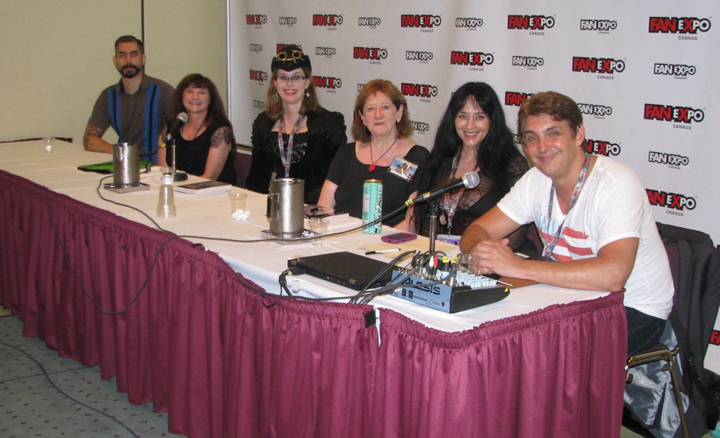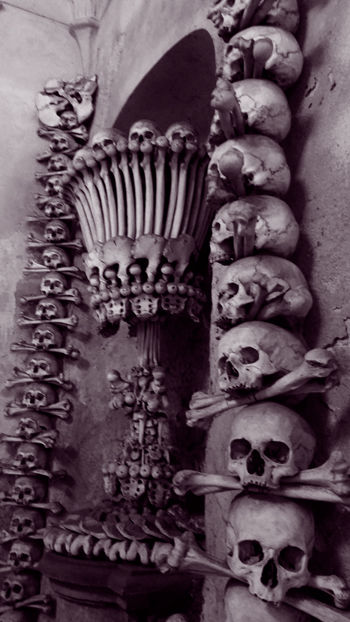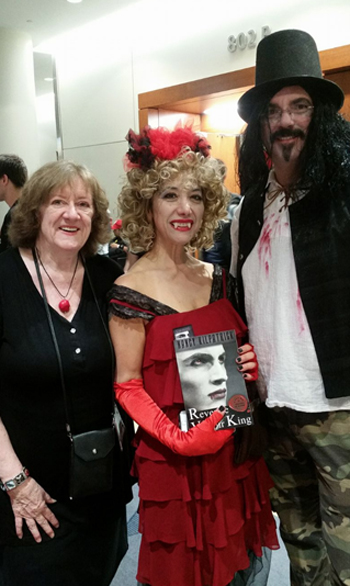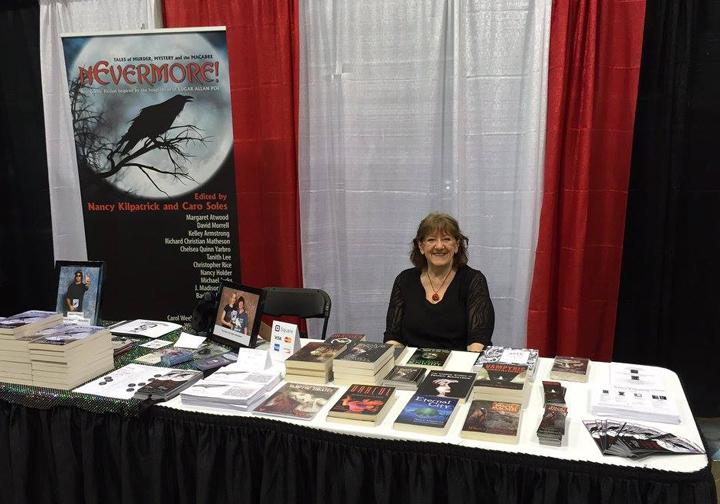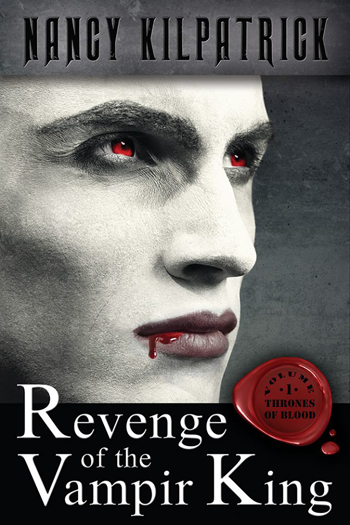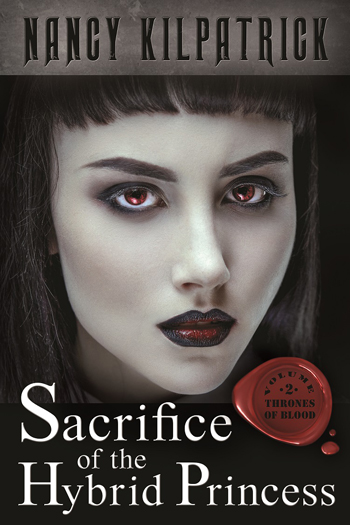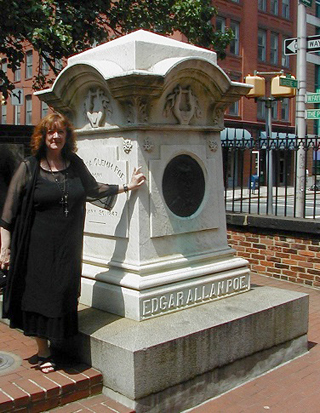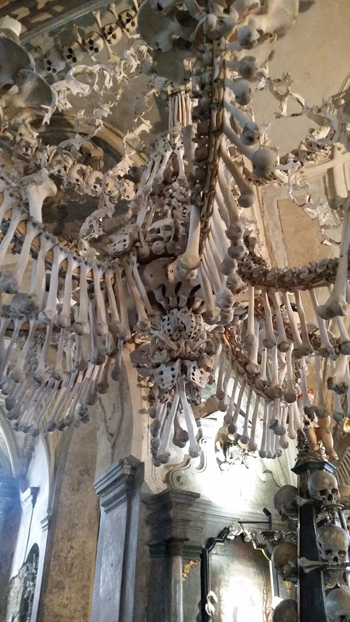The Poison Apple: The Lure of the Vampire, an Interview with Author Nancy Kilpatrick
Nancy Kilpatrick is an award-winning writer and editor. She has published 22 novels, 1 non-fiction book, over 220 short stories and 6 collections of her short fiction, comic books, a graphic novel, and she has edited 15 anthologies. Her work has been translated into 7 languages. Although not all vampire-themed, it’s all focused on the dark realm.
I noticed on your Amazon Author’s Page you did a non-fiction book about the Gothic movement.
I wrote one non-fiction book, The Goth Bible: A Compendium for the Darkly Inclined. At the time I did that I was pretty much smack in the middle of the Goth world. The agent I had at the time approached me and said there was a publisher looking for a book on goth. When I contacted the publisher, he and I had a conversation, but he was looking for something with the slant of discouraging people from getting involved in the goth culture. This wasn’t what I wanted to write so my agent shopped it around, and there was a bit of a bidding war. Finally there was an editor at St. Martin’s Press who used to be into goth when he was younger, so he bought it, but unfortunately just at 9/11, which was a paralyzing time for the publishing industry.
Despite setbacks, eventually it ended up coming together. At first I put the word out on the Internet that I wanted to interview people all over the world who were goth. I wanted to get the perspective of World Goth as opposed to just the United States or North America. In the end, I did over one hundred lengthy, extensive interviews, the same questions with everyone, Most of them also sent photos. I was looking for a way to express what goths are interested in from their perspective and not what I would be interested in which may or may not overlap. In the course of my research, I also went to retails stores that catered to goth, read and interviewed related magazines, approached fans and writers of goth literature (not to be confused with Gothic), interviewed bands, goth parents, pet owners, etc. etc. etc. The book was a massive undertaking.
Panel At FanExpo in Toronto, Canada with writers Nancy Kilpatrick (center),
Brian Clement, Stephanie Bedwell-Grime, Suzanne Church, Sephera Giron
and Richard S. Todd. Photo by Peter Coleborn.
What’s the difference?
Gothic literature would be from the mid 1700s through the 1800s. The goths I interviewed who are writers weren’t writing that type of fiction of course, but instead works that would be of interest to present day goths using modern dialogue, settings and characters. I interviewed some of the better-known writers like Neil Gaiman, Caitlin Kiernan, Poppy Z. Brite. I interviewed stores that catered to goths and companies that had anything to do with goth such as Manic Panic hair products and Urban Decay makeup — any consumer products that would be part of the goth world.
Some of the book is about what people wear, of course. Some of it is about lifestyle, because not all goths are young — several were in their forties and fifties, and goth parents with children. The parents were interesting, talking about what they go through and what their world is like. Of course there are subjects like cemeteries, animals — particularly bats, ravens and wolves, and food and drink — a nice section on absinthe. All of that is in there. It’s comprehensive and the book took me two years to compile and write.
What happened immediately was that my editor left. A new-to-the-company young woman filled the position who readily admitted that she knew nothing about goth. The book’s layout was challenging, but we persevered. Then, suddenly, the book it about to go to print and I got a distressing phone call from the new editor saying that because of 9/11, Barnes and Noble wouldn’t take the book. I was devastated, of course. But this young editor who knew nothing of goth fought like the proverbial she-wolf. She ended up writing a long defense to Barnes and Noble and managed to convince them to take copies for Los Angeles and New York City. Of course, that didn’t last very long, and all of the sudden they were putting it everywhere, but it was a major trauma along the way. The book was really popular and still is after all this time in print and in eBook. I know two people in England who met and married because of this book and we have now become friends and when I’ve got to Leeds I’ve stayed with them. Goth is an inclusive world.
Did you always want to be a writer? What was your background?
No, I never wanted to be anything in particular, but I always wrote. My grandfather gave me a tiny portable typewriter when I was a kid. It was maybe around the age of seven or eight when I started pecking out little poems. That was fascinating to me. When I got to high school I liked to write essays and short stories, but it was never a career desire and I didn’t feel ‘driven’ to write, I just enjoyed it. I had a boyfriend in my last year of high school (I was in Philadelphia at the time). He was in his first year of college and took a couple of my essays to his English prof to read, who deemed me as having “potential.” That was very nice. I was doing what a lot of people do when they are young. I wrote these angst-filled essays that were half-fury and half-wondering why things were the way they were; if there is a God then why is He doing This to Us? All that sort of stuff.
Meanwhile, at some point in 1975 I started writing my first novel, which was a vampire novel. Because I was using an old-fashioned typewriter with White-out to cover over errors, I can’t tell you how many times I had to re-type that manuscript. It was madness back then before computers. So, I had this novel. Like every young novelist, I was in love with my own book and of course you have to be when you’re young and starting all this because somebody has to love the book, so it might as well be the writer! I sent letters to 35 publishers and 34 said they didn’t want to see it. #35 did so I sent it and obeyed the rules and waited but after a year of hearing nothing, I wrote to them to see if they were interested. They didn’t reply. More time passed and I wrote again. Finally, two years later, I received a letter saying they’d sent it back to me, but of course I was still at the same address and hadn’t received it. I felt down, but not out. I then wrote another novel, non-vampire, not even horror, a kind of modern, commercial story.
Finally, I got a big agent, Henry Morrison, who wanted to represent the book within his game plan, which was this: he had eight editors in mind and would send to them all one at a time. He did. All eight rejected the book but most of the responses (which he sent me) were very positive and many wanted to see something else from me. He also wanted to see another manuscript but the only other book I had was the vampire novel and he didn’t want to represent horror. Horror back then owned 8% of the market, not much of a share and not anything most agents could parley into income. So, we parted ways.
Cosplayers from What We Do in the Shadows
with Nancy at Fan Expo in Toronto.
Photo by Pat Flewwelling.
I’ve never found that the rules work for me at all. For short fiction when I started I created a spreadsheet. Back then, there were all sorts of short story markets for horror. There were anthologies, magazines, and journals that were open to submissions. I made a list of all of them and ignored the “no simultaneous submissions policies.” Instead of sending it to one and waiting until I heard back from them I’d send ten copies out at one time, and when I’d get a rejection I’d send it to number eleven. I figured if two publications wanted the same story I’d go buy a lottery ticket that day. And that never happened. But I did get a lot of fiction published that way.
At some point I joined the Horror Writers Association. They had some anthologies they were doing. The first big one I got into was Freak Show, edited by F. Paul Wilson.–stories about a weird circus world. One thing that I want to mention is that back then the pro-rates were better. Now, they’ve leveled out at around six cents a word. For Freak Show, the rate was seventeen cents a word. A whole other world.
I managed to get into several anthologies in Marty Greenberg’s world of editing and packaging. Karl Wagner bought three of my stories for his Year’s Best Horror anthologies, and Stephen Jones bought a number of short stories from me. Eventually I wrote another vampire novel and sold that in 1993 and another in that world and a third and the original vampire novel I wrote in 1975 ended up being part of that world: The Power of the Blood, revised quite a bit by the time it saw print in 2000 because it had been a futuristic vampire novel, set in 2008 and time does march on. I turned it into a novel set in the 1960s which could incorporate some of the innovations that 2008 would see but in their beta stages.
The bottom-line — why vampires? What was the attraction?
When I was a kid, I was occasionally allowed to watch the Saturday night horror movies on television. My favorites were the old black and white vampire films. Those were the ones that really grabbed me. There were a lot of other monsters I never got as deeply into although I have written some werewolf, mummy, zombie and etc. stories. But the vampire was human at one point and looked like us and didn’t turn into a dog. I’ve loved the vampire since first meeting — a worthy opponent for human beings and, when written right, becomes the predator and we are the prey. I’ve read a lot of vampire fiction and although I didn’t intend to become a collector, I wound up with over 2,500 vampire titles in my library. Most are fiction, but some are non-fiction, analyzing the vampire or the Transylvanian warlord that many people think Stoker’s character Dracula might have been based on. There are also art books of vampire drawings and paintings, but most of it’s fiction. I loved hunting down the old books, the hard to get books, first editions, signed books. But all of this came out of the movies I watched as a child, this love of the undead, so like us, but not.
There have been so many recent vampire films and television shows, but when I think of the old stuff I think of Bela Lugosi and Nosferatu.
The silent films like Nosferatu weren’t on TV — I had to find those at rep theaters. But Bela Lugosi in Dracula and Gloria Holden as Dracula’s Daughter, they were regulars. We also had Roland in Philadelphia (John Zacherley) who did the spooky late night shows. He was vampiric, and funny! This was around the time of Vampira. Zacherley was so popular a NYC TV station picked him up. You can see some clips from his shows on Youtube.
For me, though, the ultimate Dracula was Christopher Lee in Hammer Studios Horror of Dracula. That film was a game changer. In many ways it led to all the innovative vampires that followed.
So did you say to yourself, “I’m going to grow up to be a vampire writer?”
Neither writer nor vampire writer. I didn’t think that way. I’ve never been a person with a ten-year plan. That’s not me. In fact, I was on a panel recently where all the writers heavily analyzed how they write. When it was my turn to speak I said, “Uh, I don’t know…” I just kind of feel my way through a story or novel. I know what I’d like to write and the overview of where I’d like it to go, but I don’t have a pre-set “I’ll do this, and then I’ll start to write, and it’ll fit into this and that…” That’s not how I’m wired. But I’ve worked in all sorts of ways, sometimes outlining, sometimes not. I work by feel and the thought slips into that stream.
You’re an ex-pat and grew up in the United States and wound up in Montreal, Canada. Is that the first place you went?
No, I went to Toronto first. Then I went to Montreal. Then I went back to Toronto, then Vancouver, back to Toronto and finally Montreal for the last nearly twenty years. Throughout that time I had part-time jobs to supplement the writing including the first online college teaching position in Montreal, and a lot of these positions focused not just on writing but on my expertise on vampires.
Let’s talk about your new books.
Book one is Revenge of the Vampir King. It’s the first of a series of six in the Thrones of Blood world. Book two is just out, Sacrifice of the Hybrid Princess. Because I have such a huge collection of vampire books, and because I’ve read them all, I have a sense where the vampire has been, where it is now, and where this supernatural being is going. A few years ago I edited an anthology called Evolve: Vampire Stories of the New Undead. It was wildly popular, a bestseller. Then I edited a sequel: Evolve Two: Vampire Stories of the Future Undead where I had my contributing authors project into the future how humans and the vampires we hate to love evolve together. This is a creature that’s been with us at least since 2500 BC.
Really?
The Epic of Gilgamesh mentions a death-bringer. These creatures have always been with us in nearly every culture, which means this is something important in the human psyche. It’s an archetypal energy basic to human beings everywhere (as opposed to a stereotype). It’s an energy that is alive, and we need to bring it to our awareness in some way. Like every archetype it has a positive and a negative.
Finally — yes, I’m leading into my new series! LOL — I wanted to write something that had not been done before with vampires. In my world there are the two species, and this is a world not defined in the way that it could be ours or it could be an alternative reality and the time frame is loose, making the reader use their imagination. To me, when there’s a vampire, it’s already an alternative reality. The vampires are called vampir or vampirii for more than one (a Slavic word, and an old word). The humans are Sapiens, as in Homo sapiens. These two species have been warring forever. The vampirii have been on the earth as long as the Sapiens and their initial purpose was helping human beings go from this plane — because human beings die and the vampirii don’t — helping them to go from this reality or life into death. Like Charon, the ferryman, or the Danse Macabre skeletons.
Like a psychopomp?
Yes, helping people getting over to the other side. The human beings didn’t want this, because they didn’t believe they could die or should die. That caused a lot of antagonism, plus the vampirii need blood to survive. They learned control over the centuries so they don’t have to drain living people, just take enough blood to survive. But the humans hate them, and they hate the humans, and there’s a lot of awful stuff going on between the two realms. So, the word “revenge” in the title of book one pretty much speaks for itself, and it’s about a vampir king who takes revenge, because he’s almost killed by humans. The word “sacrifice” in book two also says what that story is about.
Nancy next to Poe’s monument
What would you like to see as far as the vampire mythos is concerned?
When I did the two anthologies I mentioned earlier, I did see where the vampire could go and was amazed that writers could actually foresee the future in this way. They could project humanity and then envision the undead in a futuristic role. There are some amazing stories in Evolve and Evolve Two. For example, one story is a kind of Twelve Angry Men story, well, human jurors and 1 vampire in the room. “Six Underground” in Evolve Two is amazing.
So, it’s like come up with a wild concept, throw in vampires and make it work?
But the writers do make it work. It’s looking at how society will evolve and seeing if the undead have a place in it and, apparently, they do. Another story in Evolve Two is “Symbiosis.” It’s a post-apocalyptic tale of a starving vampire in a destroyed world and a lonely farmer who invites him in. It’s a beautiful story of beings at odds that make a connection.
I love the innovation that writers bring to stories in these two anthos. Many remind me very much of Fritz Leiber’s “The Girl with the Hungry Eyes,” and Robert Bloch’s “The Cloak.” I love when a story is new and refreshing. John Shirley has a great story in the same antho about death in the future when vampires might have a solution that humans might not like. It’s refreshing to read great writing that takes an old supernatural and reworks that clay into a modern and relevant creature.
Obviously, I don’t write vampire stuff, but what’s your take on the rules of being a vampire like, “my vampires don’t sparkle,” “my vampire does not turn into a bat” or “my vampire can look into a mirror and see his reflection.”
Every writer creates a mythos. For example, a vampire cannot leave its native soil or cannot appear in the daytime. Chelsea Quinn Yarbro’s character Count St. Germain has native soil in the soles of his boots, so this character can walk anywhere at any time. She’s very clever. She based him on a historical figure that no one quite knew who St. Germain was, and many rumors floated that seen over decades he didn’t appear to age.
Some people thought he was a Romanov. Anne Rice did an innovative interpretation of the vampire mythos. Fred Saberhagen did a completely different twist on the vampire that hadn’t been done with Dracula in Love, and Dracula is the good guy. Twilight, as you just mentioned, is to me as someone who has read so much vampire fiction including some of the other teenage interpretations such as Buffy the Vampire Slayer and The Vampire Diaries, well, I consider this more of an “arm” of vampire fiction. It’s just a piece of a bigger story. Twilight appealed to many young girls and young boys, and apparently it appeals to their mommies as well. But it’s just a drop in the bucket of blood that is the vampire and at this point, it’s history.
Church of Bones (the Sedlec Ossuary) from
recent trip to Eastern Europe
Tell me if I’m wrong, but I get the impression that Twilight is basically a teenage love story dealing with obsession.
Twilight has the good boyfriend who rescues you and wants to know how you are feeling. He’s the dream boy who is so concerned and focused on you but won’t pressure you into doing anything you don’t want to do. But the vampire all along has been an erotic creature. Fifty years before Bram Stoker’s Dracula there was Lord Varney who would sneak into the bedrooms of upper class British women. That was a serialized penny dreadful. At the end, guilt-ridden by his bad behavior, he winds up tossing himself into Mt. Vesuvius. “The Vampyre” is the first vampire story in English, written by John Polidori, who used a scrap of paper Lord Byron wrote during a weekend when they and others were holidaying on a lake. Inclement weather inspired ghost stories. (That same weekend, Mary Shelley came up with the idea for the novel Frankenstein; or, the Modern Prometheus.) Lord Ruthven in “The Vampyre” seduces the sister of his ‘friend.’ And of course Sheridan Le Fanu’s gothic novel Carmilla has all sorts of erotic undertones.
Bottom line, the vampire has always been with us and always will be. And we are intrigued as much as terrified, titillated while being horrified. The good news is, the vampire is changing and continues to fascinate, and that’s a good thing, since this archetype has no plans to vanish into the mist.
Three of Nancy’s recent titles are:
- Revenge Of The Vampir King, the first novel in the Thrones of Blood world, out now.
- Sacrifice Of The Hybrid Princess, Volume 2, is out in ebook and soon to be in print.
- Vampyric Variations, a collection of 7 vampire stories and 3 novellas, with an introduction by the wonderful writer Tanith Lee. Winner of the silver foreword reviews book of the year award (horror category)
Nevermore! Tales Of Murder, Mystery And The Macabre, an anthology that is an homage to Edgar Allan Poe, with stories by Margaret Atwood; David Morrell; Chelsea Quinn Yarbro; RC Matheson; Tanith Lee; Christopher Rice; Nancy Holder and many others — a complete list is available on the book’s listing on Amazon. Winner of the Paris Book Festival Award for Best Anthology
Nancy’s Blog: nancykilpatrickwriter.blogspot.ca
Twitter: @nancykwriter
Webpage: nancykilpatrick.com
Join Nancy on Facebook at www.facebook.com/nancy.kilpatrick.31
Elizabeth Crowens is a Hollywood veteran, journalist and author of Silent Meridian , a 19th century X Files / alternate history novel series. It won First Prize for Chanticleer Review’s Goethe Awards in Turn of the Century Historical Fiction and was short-listed as a finalist for their 2016 Cygnus Awards in Speculative Fiction, Paranormal and Ozma Fantasy Awards. www.elizabethcrowens.com, Facebook: @BooksbyElizabethCrowens, Twitter: @ECrowens
